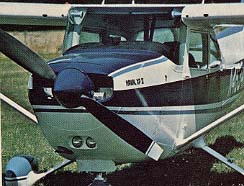
PIREP: Cessna HawkXP

Just as surely as the swallows dead reckon their way back to Capistrano and as unerringly as the IRS computer spits out your name as being overdue in your tax return, the season for 172 pilot reports is sure to return. It is a yearly thing, a ritual, a known hap-pening without which it would be felt that the entire world, even Wichita, was about to succumb to some sort of Andromeda Strain ending. For over a quarter of a century, if you include the 170s, the annual debut of Cessna's newly refined models has been ac-companied by company press releases proclaiming ". . . an all new Skyhawk more horsepower, more speed, greater climb, higher ceiling. . . . " And the beat goes on . . . and on, and on. 1977 continues the cycle.
The lowly (or lofty, depending on your point of view) 172 Skyhawk is now such a cultural artifact that a model year without a 172 would be unthinkable Aviation's philosophy seems to be "They wouldn't dare not produce the Skyhawk." (Editor's note from the year 2000: Boy, are you in for a surprise!). It is simply the most popular four-place airplane in production today, and Cessna isn't about to bury the aluminum goose that annually lays a 14 carat egg
1977 may not be the year that the 172 is transmogrified into an entirely different breed, but this is the year that the changes are far more substantial than a different paint scheme and unborn tortilla upholstering. 1977 is the year of the "XP" and to a lesser extent, of the Skyhawk/100. The Cess-na press releases call them ''. . . all new single-engine airplane . . and all new Skyhawk . . .", which may be stretching the facts a bit, but they are airplanes that step far enough ahead of their ancestors to warrant being called new generation Skyhawks.
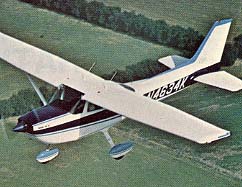 The
Skyhawk XP (marketingese for Xtra-Performance, get it?) is by
far the most significant of the two new airplanes, as It introduces
higher horsepower and the constant speed propeller to the American
172 market for the second time in twenty years. The first time
around in the '50s it was called the 175, the designation, which,
according to some owners was almost exactly the number of hours
they got between overhauls on the geared Continental. The Skyhawk
XP, however, has a leg up on the older hotrodding attempt. The
USAF has been flying 172s with big motors and constant speed props
for quite a number of years and the French Rheims Rocket, a licensed
conversion on locally assembled air-frames, has been around for
at least as long. The XP took some tips from both of those airframes
and went on from there. Its 195 hp Continental 10-360-K fuel injected
engine is actually the well-known 210 hp Continental, but all
the muffling required to meet FAA/EPA standards sucked up 15 horses.
The
Skyhawk XP (marketingese for Xtra-Performance, get it?) is by
far the most significant of the two new airplanes, as It introduces
higher horsepower and the constant speed propeller to the American
172 market for the second time in twenty years. The first time
around in the '50s it was called the 175, the designation, which,
according to some owners was almost exactly the number of hours
they got between overhauls on the geared Continental. The Skyhawk
XP, however, has a leg up on the older hotrodding attempt. The
USAF has been flying 172s with big motors and constant speed props
for quite a number of years and the French Rheims Rocket, a licensed
conversion on locally assembled air-frames, has been around for
at least as long. The XP took some tips from both of those airframes
and went on from there. Its 195 hp Continental 10-360-K fuel injected
engine is actually the well-known 210 hp Continental, but all
the muffling required to meet FAA/EPA standards sucked up 15 horses.
The Skyhawk/100---so-called be-cause it drinks 100 octane fuel-is a Skyhawk with an extra 10 horses (160 hp Lycoming 0-320-H2AD) and some minor cockpit/airframe changes that it shares with the XP. These in-clude a rudder trim (optional on Sky-hawk/lOOs, standard on XPs), a flap switch with pre-selected detents for 10, 20 and 40 degrees deflection, an instrument panel rehash that does away with some of the flimsy appearance of early airplanes, and a vernier mixture control. The throttles on both airplanes are still of the push-pull, non-vernier variety. In addition, the Skyhawk/100 had a slight .nose job, especially around the air intake to eliminate the need for running carb heat during heavy rain to prevent water ingestion
The XP is going to be the airplane everybody wants to know about. 10 extra ponies in a 172 isn't going to boggle anybody's mind, but a jump of 45 horsepower with a constant speed prop is something to sit down and think about. The empty weight is up by only 170 pounds so the power loading is down from about 14.5 lb/hp to 13.1 lb/hp, a significant decrease and something which should point to like-wise increases in performance.
The XP Hawk looks good on paper, but the only way to really find out is to go strap it on and have a go at it. As it happens, you can't just go out to your local dealer and grab an XP and go flying. First of all, the airplane is so new, that at the time of our flight evaluation they had actually finished only one production airplane. There were several prototype machines around, but only one airplane was available that was typical of what you would be likely to be buying. The other reason there was only one XP to be had was that Cessna was hit by a labor strike the same time the XPs were about to start flowing off the pro-duction line. By now, that problem should be long since solved. Anyway, the airplane we cornered at the Cessna transportation center in Wich-ita was the very first of the new breed. There were no engineering gimmick's, no fine tuning, no nothing. Just an airplane that would eventually go into the distribution pipeline to be gobbled up by a lucky consumer.
Unless you are a real Skyhawk freak, you could waddle right past an XP and never know it (assuming you can't read "Skyhawk XP" em-blazoned on the cowl). The cowl changes are very subtle. The downward flowing line of the Skyhawk cowl is replaced by a slightly curving one that runs more parallel to the longitu-dinal axis. The cowl flap needed to cool the big Continental is a single-door that mounts in the middle of the cowl's belly. It's easy to miss. The constant speed crop is nestled in a slightly larger version of a Skyhawk spinner and is painted flat black like the Skyhawk's. All in all, the XP is a sleeper, a muscle machine in sheep's clothing that won't draw any excited glances at your local aerodrome.
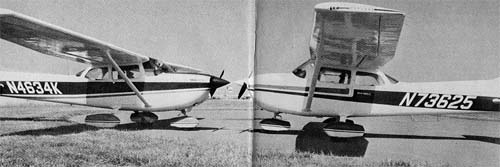
After climbing in the cockpit, I had the feeling there should be a placard about a foot square that says "This is not a Skyhawk." It looks like a Sky-hawk, it feels like a Skyhawk, every-thing around tells you you're in a regu-lar 172-so you behave accordingly. Unfortunately, 172 habits won't even get the XP started. Starting procedure calls for pushing everything, throttle included, clear to the firewall and building up fuel pressure with the momentary boost pump switch prior to cranking. When cranking the engine over, the throttle is brought back slowly until the proper air/fuel ratio is hit and the engine starts. Then, in a very un-172 move, you have to double check to make certain the cowl flap is open.
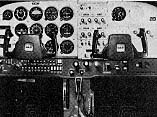 Although
it's not noticeable from the inside, when the engine lights off,
it has a very throaty exhaust tone that sounds as if it is equipped
with aug-mentor tubes. It must have been a real bear before they
were forced to throw all that muffling junk on it
Although
it's not noticeable from the inside, when the engine lights off,
it has a very throaty exhaust tone that sounds as if it is equipped
with aug-mentor tubes. It must have been a real bear before they
were forced to throw all that muffling junk on it
Cessna's airports are not exactly the places to try out an airplane's new performance; their pattern altitude is 300 ft. because it lies directly under McConnell AFB's pattern. So after a gentle 172-style takeoff, we struck out in search of greener pastures to play in.
In general, what we did with the XP that day was snoop around look-ing for places to shoot touch and goes, checking cruise performance between periods of pogo-stick activ-ity. We banged around on grass, grav-el, pavement, asphalt and some stuff we couldn't identify. We cruised at 300 ft. and 8000 ft., stalled and slow-flighted, timed speeds and gauged gallons and did everything else we could to find out what it was that made the XP different and exciting
The first takeoff will convince you that this is no ordinary Skyhawk. As a matter of fact, you'd be far better off if you'd get your brain into Skylane gear because that's how it feels. Al-though we were fairly light, full tanks and two guys, the increase in accel-eration over the 172 should stay relatively constant regardless of load. We were working in pools of our own sweat with an OAT of nearly 100° and the XP still showed the Xtra Performance Cessna was hoping it would. When you drop the hammer, the XP leaps forward and you have to gather your wits about you to make a smooth, lift -the- nose -wheel - off -first, takeoff. Most 172 drivers will have a tendency to run along nosewheel down and jerk it off from a three point position.
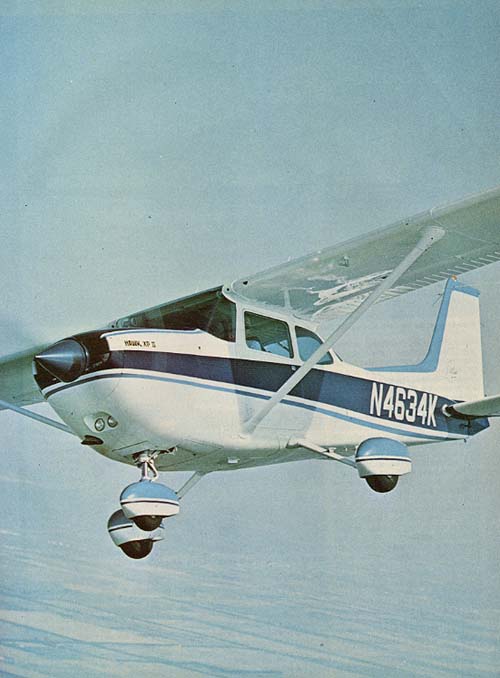 The XP
is much more a trim airplane than the 172 ever thought about being.
On takeoff, if we left the trim indica-tor in the green, it took
a determined amount of effort on the wheel to rotate and keep
the nose up. Trimming out the elevator loads with two guys on
board proved to be a bit tricky be-cause the increased weight
of the engine combined with our own weights to put the cg somewhere
out in front of the spinner. If I trimmed far enough aft to lighten
the stick loads on takeoff, I immediately had to push forward
fairly hard after rotation to keep the nose down until I retrimmed
it. With-out a doubt, the XP would probably handle much better
with several screaming passengers (they always do that with me)
strapped in the back.
The XP
is much more a trim airplane than the 172 ever thought about being.
On takeoff, if we left the trim indica-tor in the green, it took
a determined amount of effort on the wheel to rotate and keep
the nose up. Trimming out the elevator loads with two guys on
board proved to be a bit tricky be-cause the increased weight
of the engine combined with our own weights to put the cg somewhere
out in front of the spinner. If I trimmed far enough aft to lighten
the stick loads on takeoff, I immediately had to push forward
fairly hard after rotation to keep the nose down until I retrimmed
it. With-out a doubt, the XP would probably handle much better
with several screaming passengers (they always do that with me)
strapped in the back.Climbout in the XP certainly showed why they put the rudder trim in it. Without it, your right leg develops a bad torque-cramp pronto. The trim mechanism is a lever at the bottom of the console near the floor that moves left and right and right out of a cen-tered position. It has a peg on the bottom that engages holes, so you lift it up and move it a hole at a time. In climb, you need it as far right as possible. They need to structurally modify the engaging mechanism slightly because I noticed ours popped out of the hole once and it would be a simple thing to change.
At the normal climb speed of 78 kts the nose is at a thoroughly
uncomfortable angle and covers a healthy amount of sky. It gets
about 850 fpm, or about 100-150 fpm more than a stock Hawk. I
prefer to give away a little climb and go up at a flatter angle,
so I usually climbed the XP about 100 mph, which still showed
about 550 on the VSI.
When pushing over for cruise, I found it was best to close the
cowl flap before doing anything else be-cause when that door is
out in the wind it acts like a ramp and lifts the nose a bit,
changing trim. At almost all power settings I found the cruise
num-bers to be slightly better than Cessna showed on their charts.
This was prob-ably because we were at least 500 pounds under gross.
The best number we got was a timed, two-way average of 133 kt
true at 8,000 feet, as opposed to Cessna's claims of 131 TAS.
That's about 152 mph, which is a pretty sub-stantial number for
a foot dragging, dirty old airplane. That's 10 mph faster than
at least one retractable we know of.
The flight characteristics, including stalls, are traditional
172. Docile with a smallish amount of buffet, the stalls give
a little nod and sluff-off straight ahead or back into level flight,
if banked. The rate of sink goes up a little, but that's about
it. And of course, the stall warning horn is strictly Cess-na;
when it goes off, you jump a cou-ple inches off the seat.
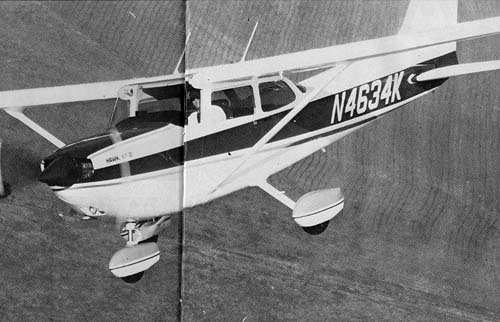
The XP is trim-critical in all flight regimes, but it gets especially important in making approaches. When slowing to approach speed, a sizable amount of trim is needed because the nose becomes extremely heavy. However, if you trim it up, you wind up having to trim it back down again when you run the flaps out. The 1.3 Vso approach speed is 60 knots, so to keep from screwing around with the trim quite so much, I flew most of the pattern at 80 KIAS right through base leg. Then I'd start the flaps out, using them to both change my rate of descent and kill speed at the same time. The trim difference between cruise and full-flap approach speed is very little and it's only in transition that the trim becomes important.
Again, because of our forward load-ing situatibn, if I flew the last portion of final with it trimmed neutral or slightly aft, the elevator pressures be-came extremely heavy during the flair. I flew the standard Skyhawk/100 di-rectly after flying the XP to verify this pressure build-up during flair and found none of this characteristic with the Hawk/100. It's undoubtedly a cg related characteristic and which can also be seen in flying a Cherokee 140, then a 180 and then a Cherokee 235, where there is a decided pressure build-up during flair in the bigger engine mod-els. With full flaps in the XP, I found it difficult to land on the main gear and hold the nosewheel off during the roll-out. Possibly because of the heav-ier elevator pressures, the XP has a larger, more anatomically shaped con-trol wheel then the Hawk/100.
Both the XP and Hawk/100 have airspeed indicators calibrated strictly in knots. There isn't a mph to be seen anywhere. This certainly causes no problems, except most of us aren't used to approaching at such low numbers; 60 KIAS looks awful low.
While flying approaches, it seemed to me that the XP was much less speed sta-ble at low airspeeds than the Hawk! 100. I had to work to hold 60k, and with full flaps adding so much drag it was certainly easy to set up a deceleration that, if left unchecked, could cause severe problems. I personally feel the XP could almost be considered dangerous in this one tiny area. The airplane will be flown mostly by low-time 172 pilots, and if they are not precise in their attitude control, they could easily find themselves decelerating into a stall. However, with all that extra power, if a guy sees himself slow and nails the nose down, a short poke with the throttle will put everything back in fine shape. Also, the wing has a slight cuff on the leading edge which will go a long way towards keeping a guy out of trouble.
Basically, the Hawk XP is available with the same variation of options as a standard Skyhawk/100. This in-cludes a stripped airplane, (and we mean "stripped") called the XP, an XP "II" version with VFR/IFR capabili-ties, or a II with Nay Pac. The prices for the three different versions were announced as: Hawk XP, $29,950; XP II at $32,650; and XP II with Nav Pac, $36,500.
It's a nice flying airplane in tbe tried and true 172 tradition . . . a machine for the short haul businessman or a Sunday pilot with his wife and kids. However, it is going to be up to the individual pilot to evaluate its advantages over the Skyhawk 100, which are slight, and decide whether it is worth the extra cost, both in acquisition and operat-ing. It's faster and more powerful but whatever its nameplate, it's still a 172, through and through. BD